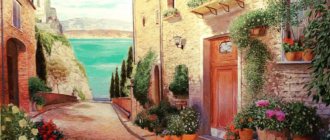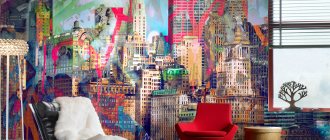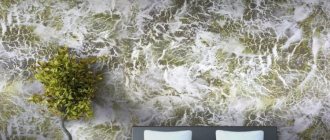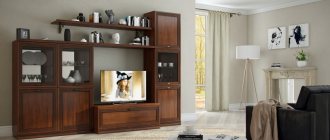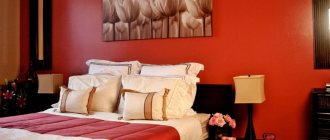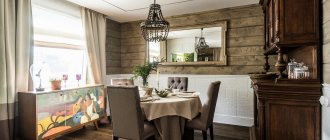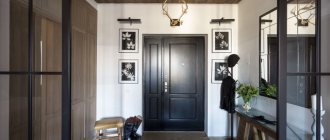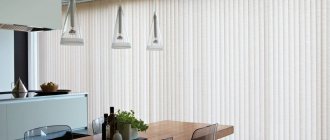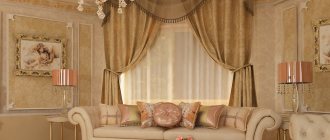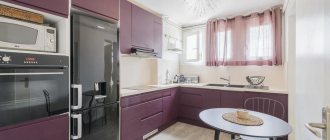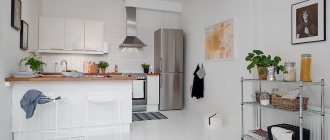The first examples of wall paintings can be called rock paintings of the Neolithic period. Even leading a primitive lifestyle, man sought not only to capture what he saw around him, but to make these pictures a decoration for his home. Each design was based on only four colors, the pigments of which could be obtained by simple processing of natural materials. They mostly depicted hunting, since this process occupied the lion's share of the time of primitive man and became the meaning of his life. There are also magnificent examples of early abstractionism: chaotically located handprints on arches and walls, creating a single artistic composition. Man improved, and the skill of painting developed along with him. Ancient Egypt became the real “cradle” of this art form. The frescoes were executed in a laconic manner, which was compensated by the monumentality of the buildings they decorated. The Egyptians were hardworking and thorough people. The secrets of painting compositions and the basics of this science were carefully preserved and passed on to subsequent generations. The central figure of the wall paintings was a person or a deity in his guise. The latter were distinguished from mere mortals by animal heads and paraphernalia that helped them fulfill their destiny (the feather of Maat, the rod of Anubis with a dog’s skin).
The main motive in painting the walls was the relationship between gods and people, as well as battle scenes. The everyday side of life did not fit into the sublime style of drawing of the ancient Egyptians. If she was depicted, it was only for ritual purposes. In Ancient Rome and Greece, they began to create more down-to-earth paintings. The deities had a completely human appearance, and everyday life began to be mentioned much more often. Bas-reliefs appeared that combined painting and sculpture. Interior wall painting began to appear more and more often in the homes of wealthy citizens. At the same time, signs began to be used that indicated the prototypes of modern cafes and other public places. In the Middle Ages, church painting began to develop. The interior decoration of temples and cathedrals was impressive in its scale and detail. Nowadays, decorative painted walls do not often decorate the interiors of rooms in ordinary apartments. This trend emerged after photo printing appeared, which made it possible to produce wallpaper with any images. Many people mistakenly believe that only a professional can handle such an exclusive interior solution, and this will inevitably involve additional expenses. In fact, even a novice designer can independently master the basics of this art form. As a last resort, there are templates that will make your work much easier. Let's try to understand the intricacies of the process and choose the optimal technique for a beginner.
Design Features
Wall painting in the interior varies both in appearance and materials. But these walls have something in common:
- A custom-made drawing on the wall is not a cheap pleasure, but it will remain in the apartment for a long time - so you need to choose the image extremely carefully.
- With the help of visual illusions, you can visually change the geometry of the room - make it taller, wider or more spacious.
- The value of artistic wall painting lies in its uniqueness, so you shouldn’t go overboard with the number of interior paintings and their sizes. Designers recommend decorating a maximum of one side or part of it.
- The wall decoration should be appropriate - cartoon and fairy tale characters in the nursery, still lifes in the kitchen, landscapes in the living room.
Modern types and techniques
Today, there are several options for painting walls - various materials, tools and techniques are used for them.
Airbrush
The artist's main tool is the airbrush. With the help of an air brush, a professional can quickly and easily create real masterpieces that amaze with their realism.
Using this method, it is easy to obtain a smooth surface and smooth color transitions without smudges or streaks. With a spray gun you can paint any motifs: from stylish abstractions and panoramas to portraits in the smallest detail.
The only drawback of modern wall painting in the interior is its high cost.
Fresco
The first mention of wall painting on wet plaster appeared in the 15th century, but it remains popular to this day.
One of the main advantages of finished frescoes is wear resistance, because if samples from the 16th-18th centuries have been preserved to this day, then such an artistic image in an apartment will definitely survive more than one renovation.
Today, when painting interior walls using this technique, they copy both today’s popular painting and create an imitation of ancient images. The second is especially in demand in classic interiors - thanks to the patina, it feels like the painting was created several decades, or even hundreds, of years ago.
Painting with fluorescent paints
Colors that glow in the dark open up possibilities for flights of fancy. Their peculiarity is that in the daytime the image looks like a simple wall painting with the most ordinary paints, and in the dark or ultraviolet radiation the design begins to glow. When choosing this option for painting walls in an apartment, be prepared to transform the room in the dark.
An unusual idea for wall painting is to apply the image with a special invisible fluorescent paint. Then during the day the picture will not be visible at all, but in the evening it will “turn on”. One popular use for invisible paints is starry sky ceilings.
The photo shows an image created with fluorescent paints
Painting with acrylic paints
The most versatile material for painting walls in the interior is acrylic paints. They have gained popularity among both professional artists and ordinary people and deservedly so. The paints are odorless, easy to apply, dry quickly, do not fade in the sun even without protective varnish and are suitable for all types of surfaces.
Acrylic is suitable for all rooms in the interior - it is environmentally friendly (which is especially good for a child's room), waterproof (after drying, a protective film is formed - this will allow you to use the paint in the bathroom and kitchen).
Thanks to the wide tinting possibilities, such wall painting in the interior can look completely different: from pastel landscapes reminiscent of frescoes to acid graffiti.
Volumetric painting
Such interesting wall painting is used when it is necessary to expand or change the space. Three-dimensional painting refers to two options:
- 3D drawing. A kind of illusion of continuation of the room. For these purposes, they often depict a landscape, a window with a beautiful view, a terrace, a bridge over a river - see the photographs below for an original example.
- Relief decor. The image is applied in several layers and seems to come out of the wall, this adds volume to the entire room. Landscapes and animals in this technique seem absolutely realistic.
Any of the technologies requires certain skills to perform, so do not try to do everything yourself - use the help of a professional. This is where the main disadvantage of volumetric painting comes from - the high price.
The photo shows 3D wall painting
Using stencils
If you are planning to paint interior walls yourself, but you don’t have the skills, use a stencil. Most often they are made in the form of various patterns and ornaments, repeating which you can easily paint over the entire wall.
All you need for successful artistic painting is the stencil itself, paints (often available as a set), a brush or roller and your accuracy. Simply apply the template to the prepared wall surface, apply paint, transfer it to another place - and so on until the end.
The advantage of this method is not only its simplicity, but also its final cost. Plus, with its help you will leave your mark on the walls.
The photo shows an example of applying an image using a stencil.
Using stencils
Stencils can be purchased at a specialty store or made yourself. You just need to find the design you like on the Internet and print it in full size. Cut out the parts from thick paper or furniture film. The second option is preferable.
The film can be immediately glued to the wall and the design can be applied with a sponge or roller. A budget and quick option for wall decoration are vinyl stickers - stickers that are sold online or in specialized departments of hardware stores.
The main thing is to remember that an interior decorated with your own hands creates a unique atmosphere and contains a part of your soul.
How does wall painting look in rooms?
The type of wall painting in the interior primarily depends on the functionality of the room in which you are going to use the technique. Let's look at the rules and ideas for each space.
Wall painting in the kitchen
No matter how durable the paints are, surfaces near the sink or stove should be avoided. Drops of water and fat, as well as temperature changes, will significantly shorten the service life of the finished masterpiece. Most often in the kitchen they choose an area near the dining table or an apron outside the wet area.
The photo shows artistic painting of the walls in the dining area
The choice of plot depends on your personal preferences:
- a neutral landscape, panorama or abstraction will correct the geometry of the room;
- a still life, a view of a cafe or a restaurant dish will set the right atmosphere.
The photo shows a drawing with acrylic paints in the kitchen
Wall painting in the bedroom
Whatever style the bedroom is decorated in, this room is primarily a place of recuperation. Therefore, there should be no aggressive or bright art - only delicate colors, smooth lines, neutral sketches.
The most suitable subjects are flora and fauna, calm landscapes (without waterfalls and elements), 3D panoramas.
If you still prefer more active paintings, place them behind the head of the bed and plan the arrangement of furniture so that nothing is reflected in the mirrors. This way you will see the fresco not before going to bed, but only after waking up.
In the photo there are floral motifs behind the head of the bed
Wall painting in the living room
The only room in which there are practically no restrictions on choosing a plot is the hall. The main requirement is that the image must match the style and temperament of the entire interior.
In the living room, natural or city landscapes, abstractions, reproductions of famous paintings, and portraits of people are most often depicted.
Based on your style, choose as follows:
- blooming gardens and marine landscapes for a classic interior;
- black and white colors in abstraction go with minimalism and hi-tech;
- Lavender fields fit best into Provence.
The photo shows an example of interior wall painting in a studio
In the children's room
When decorating a children's room, every adult has the right to become a child again and throw away all boundaries! Most often, the brightest colors and unusual stories are used here. Heroes of fairy tales and cartoons, magical forests and castles, favorite animals - these are not all the options for a child's room.
To paint a wall on wallpaper or plaster, use organic acrylic paints - unlike oil or any other paints, they are safe and environmentally friendly.
Examples in the hallway and corridor
The use of wall painting in the hallway interior will make this boring space much more interesting. Choose only one most noticeable side and place an abstract canvas or a view of a city with streets on it.
Since painting in itself is an accent in the interior, in small rooms you should not use bright shades - a black and white palette or even a single color painting is possible.
In the photo there is a drawing on the wall in the corridor
Beginning of work
Once the drawing is selected, it’s time to transfer it to the wall plane. First you need to level the surface using a primer. If necessary, use sandpaper.
For work you will need: stencils, acrylic paints, art brushes. Don't forget about special jars for mixing paint. You need to stock up on brushes of different sizes.
Selection of drawing and plot
We have already touched on the theme of the paintings and said that it should correspond to the room. Let's take a closer look at the choice of design.
Living room.
- Yes: abstraction with 3D effect, nature, city, portraits, geometry, graffiti.
- No: food, fairy tales.
Kitchen.
- Yes: food, ready meals, still lifes, kitchen utensils, photography of a cafe or restaurant.
- No: children's drawings, cartoon characters, dark tragic pictures.
Bedroom.
- Yes: landscapes, flowers, abstractions.
- No: scenes of aggression, animals, large portraits, raging elements, bright acid paintings.
Cabinet.
- Yes: book covers or shelves with them, classical paintings, maps of countries or the world.
- No: children's stories on a bright background, food, flowers, animals, graffiti.
Bathroom.
- Yes: marine theme, landscape, flowers, abstraction.
- No: large images of people and animals, still life.
The photo shows an artistic painting with fairy tale characters
Based on the interior style, the following patterns can be identified:
- Modern. Abstract motifs, large flowers, airbrushing, reproductions of paintings by contemporary artists are suitable.
- Classic. Ideal for painting on the wall in the form of a landscape, floral details, reproductions of classical paintings, ornaments.
- Oriental. The directions are best reflected by ornaments and arabesques, images of dragons, hieroglyphs, and reproductions of Guohua paintings.
- Provence. The main decorative element is flowers. Roses, lavender, tulips.
- Art Deco. A geometric ornament, a repeating pattern or an image imitating the texture of marble will fit perfectly.
- Loft. If the image of brick or concrete seems boring, add graffiti.
- Eco. The texture of wood is best, a bamboo forest or a beautiful field also looks amazing.
In the photo there is a designer wall painting with images of birds
